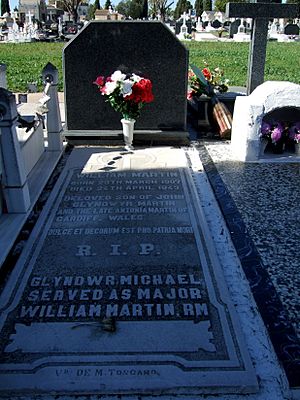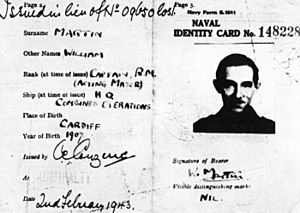William Martin (Royal Marines officer) facts for kids
Major William Martin was a fake person created by British spies during World War II. He was part of a clever plan called Operation Mincemeat. This plan tricked German forces into thinking the Allies would attack Greece. The real target was Sicily.
Major Martin was also known as "the man who never was". His fake life story was made to make the plan believable. The plan involved a dead body dressed as a British officer. This body carried fake secret documents. The idea was for the body to wash up on the coast of neutral Spain. It would look like he died in a plane crash. The spies hoped these documents would fall into German hands. The papers suggested an Allied attack on Greece was coming.
The real identity of the body used as Major Martin was kept secret for many years. People wondered who he was. In 1996, the body was identified as Glyndwr Michael. He was a homeless man from Wales. The Commonwealth War Graves Commission now recognizes him.
Contents
Operation Mincemeat: A Clever Trick
The main goal of Operation Mincemeat was to mislead German spies. The Allies wanted them to believe a fake invasion plan. This plan was about attacking southern Europe. To make the fake documents seem real, they put them on a dead body. This body was dressed as a British Marine officer. He also carried personal items to prove his identity.
Finding a suitable body was hard. Spies could not ask too many questions. They also could not tell a dead person's family what the body was for. A good body was found. A lot of effort went into creating Martin's fake life. This included an identity card, dog tags, fake letters, a photo of a girlfriend, and even theatre tickets.
On April 30, 1943, Lieutenant Norman Jewell was the captain of the submarine HMS Seraph. He read a prayer. Then, "Martin"'s body was gently pushed into the sea. The tide and the submarine's propellers helped carry it ashore. It landed near Huelva, on Spain's Atlantic coast.
A briefcase was attached to Martin's body. It held fake secret documents. These papers were made by the British Security Service. The goal was to make German intelligence think he was a messenger. They wanted the Germans to believe he was delivering important papers to a British general. The documents were designed to trick the Germans. They suggested the British were getting ready to invade Greece and Sardinia. The real target was Sicily.
A fisherman found Martin's body. Just as planned, the documents he carried reached German intelligence. The operation was a big success. The invasion of Sicily happened more easily and quickly than expected.
Who Was Major Martin Really?
Ewen Montagu's Story
Ewen Montagu was the officer in charge of Operation Mincemeat. He had to find a body for the fake Major William Martin. Bentley Purchase, a coroner (a person who investigates deaths), helped him. Montagu wrote a book in 1953 called The Man Who Never Was. In it, he said it was hard to find a body they could use.
He claimed they found the body of a young man who died from pneumonia. Permission was given to use the body. Pneumonia was important because it caused fluid in the lungs. If doctors checked the body, this fluid would look like the person had drowned. Montagu said the body was used on one condition: the man's real name would never be told.
However, some historians say Montagu's claims were not fully true. For example, historian Ben Macintyre says the dead man's parents had already passed away. No other relatives were found.
Glyndwr Michael: The Real Identity
Quick facts for kids
Glyndwr Michael
|
|
|---|---|
| Born | 4 January 1909 Aberbargoed, Monmouthshire, Wales
|
| Died | 28 January 1943 (aged 34) St Pancras Hospital, London, England
|
| Resting place | Soledad cemetery, Huelva, Spain |
| Occupation |
|
In 1996, an amateur historian named Roger Morgan found new information. He looked through old records in the Public Record Office. He discovered that the body used was a Welshman named Glyndwr Michael.
Michael was born in Aberbargoed, a town in South Wales. He worked part-time as a gardener and labourer. He later became homeless and sad. He had no money or friends. Michael moved to London and lived on the streets.
Michael was found very ill in an empty warehouse near King's Cross. He had accidentally eaten rat poison. Two days later, he died at age 34 in St Pancras Hospital.
The poison he ate caused a lot of fluid to build up in his lungs. This was important because it made his lungs look like someone who had drowned. This matched the story of Major Martin dying at sea. When the coroner, Bentley Purchase, got Michael's body, it was in good shape. It looked like a man who had floated ashore a few days after dying at sea from cold and drowning.
Other Ideas About the Body
After Glyndwr Michael was identified, some people had doubts. They wondered why Montagu would use a body that wasn't physically fit. A Marine officer would likely be in good shape. Also, Michael didn't die by drowning or in a plane crash.
In 2004, John and Noreen Steele suggested a different idea. They thought the body might have been a serviceman. They pointed to the sinking of HMS Dasher in March 1943. Many sailors died in that accident. A sailor would be fit and would have died in a sea accident. This would make more sense for the story. They named the person John Melville. However, the Royal Navy later said this was a mistake. John Melville was buried in Ardrossan Cemetery.
Another person, Colin Gribbons, also looked into the Dasher incident in 2003. He thought the body was another sailor from the Dasher, named Tom Martin. But Glyndwr Michael remains the officially recognized identity.
Remembering Major Martin

The body was buried with full military honors. He was buried as Major William Martin. His grave is in the San Marco section of the Nuestra Señora cemetery in Huelva, Spain.
A special plaque remembering Glyndwr Michael was added to the war memorial in Aberbargoed. It says Y Dyn Na Fu Erioed, which means "The Man Who Never Was."
Glyndwr Michael's story has been told in many ways. He has been featured in plays like Mincemeat (2009) and the musical Operation Mincemeat. His story also inspired films like The Man Who Never Was (1956) and Operation Mincemeat (2021).


